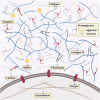Heterogeneity and versatility of the extracellular matrix during the transition from pleomorphic adenoma to carcinoma ex pleomorphic adenoma: cumulative findings from basic research and new insights
- PMID: 37138857
- PMCID: PMC10149834
- DOI: 10.3389/froh.2023.942604
Heterogeneity and versatility of the extracellular matrix during the transition from pleomorphic adenoma to carcinoma ex pleomorphic adenoma: cumulative findings from basic research and new insights
Abstract
Pleomorphic adenoma (PA) is the most common salivary gland tumor, accounting for 50%-60% of these neoplasms. If untreated, 6.2% of PA may undergo malignant transformation to carcinoma ex-pleomorphic adenoma (CXPA). CXPA is a rare and aggressive malignant tumor, whose prevalence represents approximately 3%-6% of all salivary gland tumors. Although the pathogenesis of the PA-CXPA transition remains unclear, CXPA development requires the participation of cellular components and the tumor microenvironment for its progression. The extracellular matrix (ECM) comprises a heterogeneous and versatile network of macromolecules synthesized and secreted by embryonic cells. In the PA-CXPA sequence, ECM is formed by a variety of components including collagen, elastin, fibronectin, laminins, glycosaminoglycans, proteoglycans, and other glycoproteins, mainly secreted by epithelial cells, myoepithelial cells, cancer-associated fibroblasts, immune cells, and endothelial cells. Like in other tumors including breast cancer, ECM changes play an important role in the PA-CXPA sequence. This review summarizes what is currently known about the role of ECM during CXPA development.
Keywords: carcinogenesis; carcinoma ex pleomorphic adenoma (CXPA); extracellular matrix (ECM); pleomorphic adenoma (PA); review.
© 2023 Scarini, de Lima-Souza, Lavareze, Ribeiro de Assis, Damas, Altemani, Egal, dos Santos, Bello and Mariano.
Conflict of interest statement
The authors declare that the research was conducted in the absence of any commercial or financial relationships that could be construed as a potential conflict of interest.
Figures

References
-
- Bell D, Bullerdiek J, Gnepp DR, Schwartz MR, Stenman G, Triantafyllou A. Pleomorphic adenoma. In: El-Naggar A, Chan JKC, Grandis JR, Takata T, Slootweg P, editors. World health organization classification of tumours. Lyon: IARC Press; (2017). p. 185–6.
-
- Gnepp DR. Malignant mixed tumors of the salivary glands: a review. Pathol Annu. (1993) 28(Pt 1):279–328. Available at: http://www.ncbi.nlm.nih.gov/pubmed/8380049. - PubMed
Publication types
LinkOut - more resources
Full Text Sources

